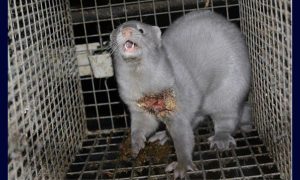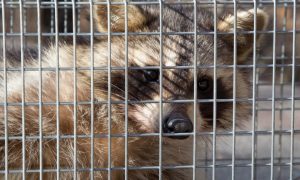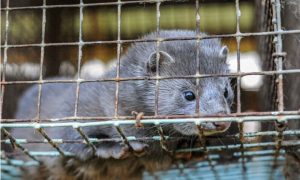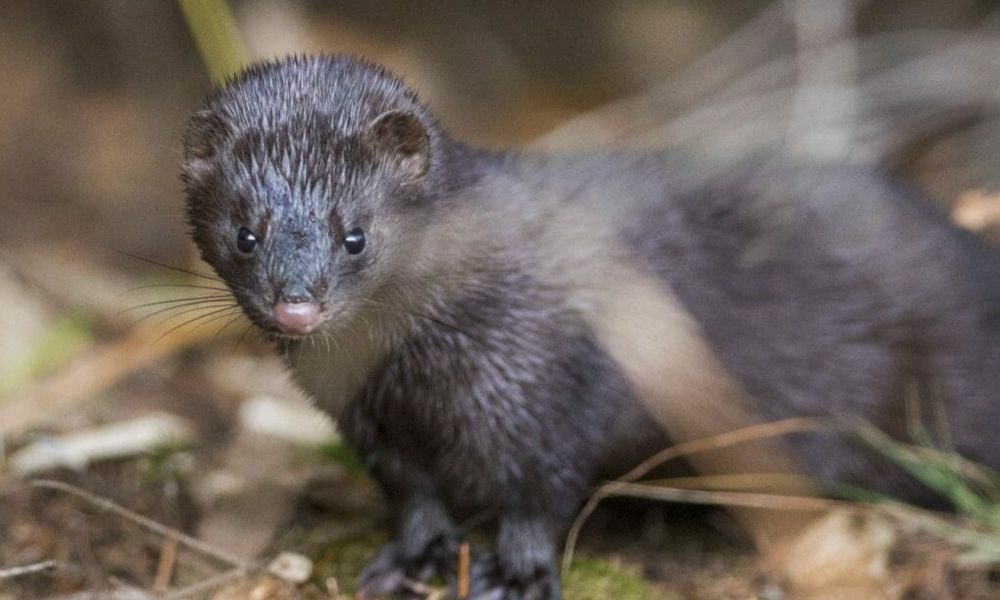Twenty years ago, Matt Rossel took a job working undercover at a fur farm in Illinois.
He witnessed foxes and racoons crammed into tiny cages, deprived of water and everything that is natural for them. He also witnessed breeding pairs of foxes who cannibalized their cage mates and corpses left in cages with living animals.
“The things I witnessed there on a daily basis were horrific,” he said. “That was 20 years ago, and sadly, the industry hasn’t changed.”
The investigation brought in authorities, who fined the fur farmer but let him keep operating, Rossel said. But a silver lining to this tragic — but not atypical — situation is that Rossel got “paid” with 10 baby foxes, whom he rehabilitated and released to the wild.
The other silver linings are that fur production is at an all-time low in the United States, that there’s legislative momentum to help animals through fur sales bans, and that major fashion designers and the public are increasingly condemning stripping animals of their skins, Rossel said during a webinar presented by the Animal Legal Defense Fund (ALDF).
“Around the world, people have realized the need to protect these animals with laws,” Rossel said. “There are public health and environmental risks. But most importantly, animals are still suffering from intensive confinement and neglect and are being painfully killed.”
Here are some highlights from the talk, presented by Rossel, now ALDF’s campaign manager, and ALDF Campaigner Abbey Benesh — including how you can use your voice to advocate for furbearers today.
A Cruel Industry Impacting Multiple Species — Including People

Representative Image (Oikeutta eläimille/ Wikimedia Commons)
Fur enters the market through two main sources: fur farms and wild-caught animals.
The plight of mink catapulted into mainstream media following outbreaks of COVID-19 on fur farms that proved that the cruelly confined animals could catch and pass the potentially fatal disease on to people.
But mink aren’t the only animals raised and skinned for their furs. Other species include chinchillas, beavers, coyotes, lynx, rabbits, and seals. Even cat and dog fur has been found sold in the United States, despite the nationwide prohibition against it, Rossel said.
Undercover investigations have revealed atrocious conditions at fur farms, including animals kept in barren and filthy cages, left exposed to extreme weather, and killed by viciously inhumane methods including suffocation, electrocution, poison, and gassing — all methods that leave their skins intact, Rossel said.
Animals caught in the wild also face horrific cruelties, including being trapped in vicious steel-jaw snares where they can be left for days only to be shot, drowned, or bludgeoned to death when trappers return, Rossel added.
Beyond the animal cruelty involved, fur farming also has serious repercussions for people and the planet. Fur farms — with their stressed animals intensely confined in unsanitary conditions — often are breeding grounds for zoonotic disease, as the COVID-19 pandemic proved. Fur production also harms the environment by using toxic chemicals and generating waste, Rossel added.
What Fur Sales Bans Do And Why They Matter

Representative Image (Canva)
Fur sales bans typically are bills that pass at the local or state level and prohibit the sale of new fur products, including clothing, accessories, and home decor.
Many countries abroad — including Ireland, the United Kingdom, France, and Belgium — have existing fur farming bans. California became the first and only U.S. state to issue a state-wide fur sales ban in 2019.
But municipalities also have passed local ordinances banning brutal, new fur products within their jurisdictions — including Ann Arbor, Michigan; Hallandale Beach, Florida; Cambridge, Massachusetts; and Boulder, Colorado.
Local and state legislation makes a difference because it often sets a foundation for legislation at the federal level, Rossel said.
Lobbying Tips 101, Courtesy of ALDF

Representative Image (We Animals Media)
Benesh said people with connections to influential people in their communities — including mayors, local celebrities, and prominent business owners — can ask for a meeting to discuss their possible support for a local fur sales ban. That’s what’s known as “Grasstop advocacy.”
Her tips for people wanting to help create a fur sales ban in their communities at the grassroots level:
- Find a sponsor. Research which local legislators may be sympathetic and willing to sponsor a ban.
- Schedule a meeting. Benesh said not to be disheartened if you end up meeting with a council member’s aide, rather than the actual council member. Leaving a positive impression and building a relationship with the representative will still get your concerns heard.
- Be Prepared. Dress professionally for the meeting. Bring along a 1-page fact sheet outlining the cruelties of fur and a longer “Frequently Asked Questions” resource to counter any concerns that the legislator may have. (ALDF has already-created resources here for your use!)
- Be Positive and Professional. Benesh said it’s important to remain positive, professional, calm, and kind. Listen carefully and take notes. If the legislator asks a question you can’t answer, she said it’s fine to say, “That’s a great question. I’m not sure right now, but I’ll look into it and get back to you after the meeting.” It also helps to present legislators with similar legislation passed in other states or cities of comparable size — such as California’s statewide ban, Assembly Bill 44. Legislators typically are more willing to take a leap if they know other cities have successfully gone before them, Benesh said.
- Don’t Give Up. The legislative process is long — sometimes taking months to years to pass needed bills. Advocates should be willing to stay the course. But Benesh added there are periods of waiting or “down time” in between steps of the legislative process so that advocates won’t need to work 24/7. It’s more about bursts of advocacy, she said.
How You Can Help Furbearers Today
ALDF recommends that people who want to make a difference for foxes, mink, racoons, beavers, and other fur bearing animals can start with the following steps.
- Support the Mink VIRUS Act (H.R. 3783): This piece of federal legislation would phase out U.S. mink farming. You can quickly find and send a message to your legislators by using the ALDF action form here. Rossel strongly encourages people to also follow up with a phone call to legislators; you can find your legislators here. And if you haven’t already, please also sign and share Lady Freethinker’s petition in support of this important bill!
- Build a Network: One of the first steps in grassroots advocacy is building a community of people who will create momentum! Rossel encourages people to look for possible partnerships with existing rescues, nonprofits, and vegan advocacy or animal protection groups, go to protests, or search for groups on social media. He also advises keeping track of everyone who expresses interest for when it’s time to gather everyone together and act.
- Start a Fur Sales Bill in Your Community: After you’ve built a network, see ALDF’s Lobbying 101 tips above for starting a fur sales ban in your community.
- Advocate through Grassroots Actions: If talking to legislators directly doesn’t suit you, you can also help fur bearers by raising awareness through action alerts posted to social media. Benesh recommends keeping your calls to action short, specific, and easy, and including sample messages or “scripts” that other advocates can use when contacting stakeholders. She repeated that it’s beneficial to always remain kind, calm, and courteous when advocating for animal
We hope you’ll take action for these precious animals today in whatever way most resonates with you! Thank you for helping us make a difference for animals.








